A dairy goat is one of the most useful animals you can keep, they are ideal for a small farmer as they are easy to look after and feed. They produce excellent quality milk which can easliy be made into cheese, butter and yogurt. Unwanted kids are excellent as a source of meat for the house, the skins tan well and the fat is used to make soap, as well as all that you have a marvelous source of manure for the garden. The goat is also a lovable animal to have around.
Dairy Goat Breeds
A Dairy goat may be of four different breeds or a cross breed. The four dairy breeds are Saanen (white or cream with upright ears), Toggenburg (brown & white with upright ears), British Alpine (black & white with upright ears) and Anglo-Nubian, (multi-colours, roman nose and long pendulous ears), a cross breed may be any combination of these or a dairy goat crossed with a fleece goat.
There are two experimental dairy breeds in Australia which are all brown and all black.
Anglo-Nubian
A dual purpose milk and meat goat that originated in England in the 1870's from the crossing of Nubians from Egypt, Jumna Pari and Chitral goats from India and Zariby Eritrea. These goats were many colored - black, tan, mottled and spotted. There are two distinguishing features of the Anglo Nubian - the long pendulous ears and the roman nose which is markedly convex in shape. Stance is very upright and proud.
The first Anglo Nubian was imported into Australia in 1956 - Playford Petulant from England. They are now established in all states.
Features of the breed are the high butterfat and protein content in their milk and their superior flesh compared to the Swiss breeds. It is a very useful dual purpose animal, having a great capacity for adaptation to hot climates.
General Apperance
Dark skinned, large exotic goats of regal bearing, being one of the tallest and heaviest of the breeds with bucks weighing up to 140 kgs and does 110 kgs. Elegant head with arched roman nose, long pendulous ears, muzzle fine and tapered, nostrils flat. Chest broad, heavy framed body with back straight or slightly rising to the hips. Legs strong and straight. Coat short and fine being any color combination except full Swiss markings. Ideal height for bucks 94cm, does 81cm.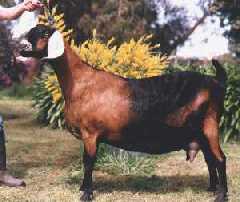
Figure 1: Anglo-Nubian dairy goat.
Bristish Alpine
The first documented British Alpine was Sedgmere Faith, a doe or the Sundgau breed, found in the Paris Zoo in 1903 and taken to England, where she became the foundation of the breed. In 1956, Mrs. Hopping of Ferncliffe Stud in New Zealand imported one buck, Kewell Kiltie, and two in kid does, Digemere Dessane and Tamar Mary from England. These were the first British Alpines in the Southern Hemisphere. In 1959, four British Alpines, two bucks and two does, all related, came to Australia and it was from their descendants and the out-crossings to Toggenburgs and Saanens carrying the Alpine type as a recessive, that the breed was established here.
British Alpines in Australia are one of the minority breeds. The Dairy Goat Society of Australia has implemented a plan to help broaden the genetic pool by allowing grade bucks to be registered and also allowing the upgrading of appendix does which qualify on inspection and milk figures, and their male kids to be a special herd book section. The results will not be realised for a number of years when there is sufficient stock to asses. British Alpines are a highly active breed suited to free range and are noted for good quality milk.
General Apperance
The British Alpine is a striking, rangy, black animal with white leg and facial markings, white under the tail, with ears outlined in white also. Facial line is dished or straight, with strong broad muzzle, ears erect pointing slightly forward. Back straight or rising slightly to the hips. Body deep and wedge shaped, legs strongly boned and straight. Skin dark. Ideal height for does 83 cm, bucks 95 cm.
Figure 2: British Alpine dairy goat.
Toggenburg
Originating in Switzerland and taking it's name from the district of Obertoggenburg, and being the most numerous type of goat in that area, this ancient and popular breed has been widely exported throught the world and was particularly popular in Great Britian between 1884-1905, being the first of the Swiss breeds to arrive there. Toggenburgs are the most numerous breeds in the USA, where they have held their popularity to the present day. The ancestors of the Australian Toggenburg were imported from Great Britian in 1947. They have adapted well to our moderate climatic regions, in which they do equally well as house goats or on free range, holding their place as good milk producers in larger herds.
Between 1947 to 1953, twenty Toggenburgs were imported from the Northmoor Stud in England, of which only three were Pure Toggenburgs, the remainder being of British Toggenburg origin, a rangy larger type.
The highest production for an Australian Toggenburg for 24 hours is held by Stoora Signorita * with 9.30 kgs (9.03 litres). The highest yearly production is held by R304 Murrungowar Jeneva *Q*3 with yield of 3047 kgs (2958 litres) in 365 days and was recorded in the 1999/2000 season.
General Appearance
A robust dairy type, active and vigorous, being well proportioned with strong backline straight to the hips. Full chested with large deep wedge shaped body. Well boned strong straight legs. Coat color may be from light fawn to dark chocolate with white facial stripes from eyes to muzzle, around edges of ears, on legs from knee and hocks to feet, on rump and tail. Ideal height for does 79 cm, bucks 90 cm.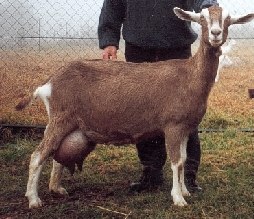
Figure 3: Toggenburg dairy goat.
Saanen
The early goats brought to this country were mostly the tough adaptable type only a step or two removed from what we now know as a "bush" goat. In 1913, the NSW Department of Agriculture imported two bucks and ten does from France and Switzerland to improve the existing standards over the next twenty years at their experimental farm at Nyngan. This work was followed on at Condobolin for a number of years and today goats with the "State" prefix are still to be found in the pedigrees of some of our finest animals.
The Saanen breed has reached such a high standard that Australian Saanens have frequently held the world production record and are continuing to do so. The present world record for 365 days lactation is held by Osory Snow Goose with 3296 kgs (3200 litres) first lactation, 3498 kgs (3396 litres) second lactation.
Saanens have quite a placid nature and are equally suited to both small holdings with just a few goats and the larger commercial milking herds. The Saanen has been, and still is, the numerically strongest breed in Australia so there is a larger pool of stock to select from, thus enabling good herd averages for production to be achieved.
General Appearance
An attractive dairy type. Tan or olive skinned - black spots may appear on the skin of ears, nose or udder. Short fine white coat. Slender head with a dished or straight facial line, ears erect and backline straight. Legs straight and strong. Body wedge shaped with well sprung ribs. Ideal height for does 81 cm with weight around 61 kgs, bucks 94 cm and weight around 81 kgs.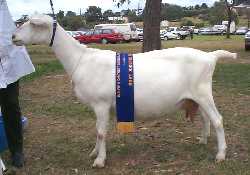
Figure 4: Saanen dairy goat.
Other Breeds
At the 2001 Federal Council meeting of the DGSA the All Black dairy goat was officially recognised as a breed in it's own right and named The Australian Melaan.
There are not too many other experimental breeds in Australia at present except for the All Brown and until such time as breed standards and registration and appendix systems have been certified and put into place, information about these breeds is a bit scarce.
General Description
Elegant, tall, rangy and graceful, with smoothly blended body exhibiting a pronounced dairy wedge shape. Fine without tending to weakness. An alert expression and stance, combined with a docile temperament. Does should be feminine, bucks obviously masculine in appearance.
Figure 5: The all brown and Australian Melaan dairy goats.
Breeding
A doe is a female goat over two years of age, a buck is an adult male goat over two years old, a goatling is a doe over twelve months and under two years, a buckling is a male over twelve months and under two years and a kid is under twelve months old.
Dairy goats breed each season. Most does come on season from late summer through to early winter. The doe has an 18-21 estrus cycle. The doe is usually in season from a few hours to a few days. It takes five months for the doe to have kids. Twins are very common and some does have triplets or quads. A good milking doe will milk for a year after kidding, many will milk longer if they are not joined to a buck again.
During the breeding season a buck has a strong ‘musky’ odour. Does do not have any odour at all. Many small herds do not keep a buck and you will need to find a breeder who is prepared to take your does for service. Most breeders require a vet’s certificate to state that the doe has tested negative to certain diseases.
Doe kids can be fertile from three months of age so they need to be separated from the buck kids.
Shelter and Fencing
It is essential that some type of shelter is provided for any goat, this may be a proper shed or a smaller “A” frame in a paddock. Goats do not take kindly to rain and wind and are susceptible to respiratory diseases, this particularly applies to the dairy goat who does not have the protective coat of the fleece animal. The floor of the shed needs to be easily cleaned and well drained. Goats dislike cement floors as they become very cold.
Straw makes a good bedding for sheds, barley straw is preferable to oaten straw as it doesn’t stain as easily. Sheds need to be well ventilated with good supply of fresh air but not draughts. It is not suitable to keep goats in an open paddock without some kind of shelter or tethered at the side of the road.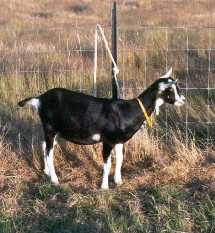
Figure 6: Tethering goats is not a good idea as they can strangle themselves.
Goats are very clever they will quickly learn to escape through the smallest gap in the fence. They are much more intelligent than sheep and will keep going back to the same spot. If you teach kids to respect fences you never have any trouble. A good fence can be made using the smaller pig mesh (8,80,15 hinge joint) and two plain wires on top. If you have ordinary farm fencing an electric fence works well providing you leave it turned on. You need good latches on your gates as clever goats soon learn to open them.
Feeding
Goats DO NOT in fact eat just anything! They may try different foods once but will not eat food that has been dropped on the floor or poor quality hay.
Goats do not thrive under the same conditions as sheep and dairy cows as they are a browsing rather than grazing animal. Goats like to graze good pasture but their diet must also contain ample roughage, some concentrates and a supply of bushes, weeds or rough scrub to give variety.
Roughage forms a large part of the diet. Dairy goats need to be fed good quality roughage in the form of hay each day. Milking does need about 1.5 kg of lucerne hay daily, more if they are very high producers.
For a dairy goat to milk well and maintain condition you need to feed them well, a dairy goat will not milk and survive well on grass alone! A goat producing four litres of milk per day will need at least 2.5 kg of concentrates per day as well as access to good quality lucerne or clover hay. A good rule is to feed 500 grams of concentrates for every litre of milk produced and 500 grams for maintenance. A crude protein mix of 12 - 14% will give good results.
You could mix up the following ration for your dairy goats. Use a 9 litre plastic bucket, 3 buckets lucerne chaff, 2 buckets oats or barley, 1/2 bucket of lupins or dun peas. To this add 1/4 of a 500 gram margarine container of dolomite and the same of seaweed meal.
To teach a goat to eat concentrates you need to start when they are kids, offer kids bran at 4 weeks of age and gradually increase the amount. Goatlings and kids do not need as much concentrates as milkers as they can quickly become over fat. They need about a margarine container per day and some lucerne or clover hay. A pregnant doe needs to slowly have her ration increased during the last eight weeks of pregnancy. This is called “steaming up” during this time the growth of the kids is very rapid and the metabolic rate of the goat rises rapidly. The full ration that she will receive as a milker should be reached about a week before kidding. Good feeding at this time will help avoid pregnancy toxaemia.
A buck needs a ration of hay and 500 grams of concentrate daily to maintain condition.
Allow goats access to a mineral block. These come in a variety of types. Ollsons “go-blocks” are specifically for goats. Access to good clean water is essential as a milking animal needs to drink a lot of water each day. You can add unpasteurized cider vinegar to the drinking water. Cider vinegar is meant to help prevent kidney stones in bucks, help with kidding and the general health of the goat.
Goats of all kinds enjoy branches, some suitable trees are Blackwood wattles and Acacias, goats really enjoy rose clippings and vegetable scraps. Be aware that Azaleas, Rhododendron, Oleander, Potatoes, Rhubarb and some Gum trees are highly poisonous to goats.
Hoof Trimming
How often you trim depends on the type of ground you have, goats that live on rocky, hilly properties will need less foot trimming than goats who live on softer ground. You need a good sharp pair of footrot shears and a small woodworkers rasp is a good investment for smoothing off the soles of the feet.
It is a good idea to start trimming the feet of kids at about four weeks of age, they get used to it and you never have any trouble. A good way to learn to trim feet is to find an experienced goat keeper to show you how to do it.
First, tie the goat up securely. Start with the front feet, stand at the side of the goat and lift the foot up. This gives you a good position to trim the feet. For the back feet stand at the back of the goat and lift the leg between your legs. Below are some diagrams on how to trim feet.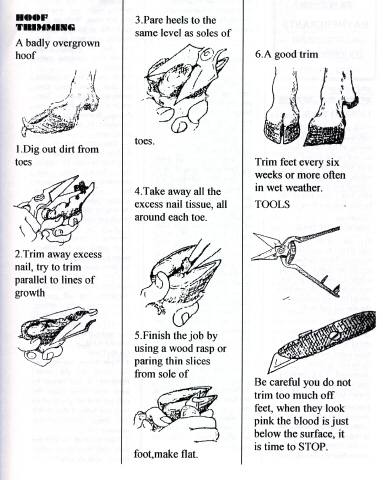
Acknowledgement
This information is courtesy of the Dairy Goat Association, Victorian Branch.
News Category


